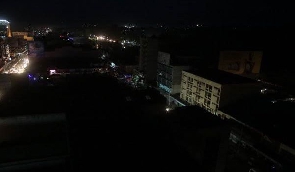Some Observations and Recommendations
Little investigation I carried out into the recent nationwide power shutdown on Sunday, 7th March 2021, clearly points to an Ineffective Auto Under-Frequency Load Shedding (AUFLS) control system on Ghana’s power generation and transmission systems.
In power generation and transmission system, one most important protective measures used to prevent sudden and complete power shutdown is the use of Auto Under Frequency Load Shedding (AUFLS) Scheme.
This control system is exactly what Ghana power system lacks and must install with alacrity to prevent reoccurrence of the last Back Sunday.
The purpose of AUFLS is to balance power generation and load in situations where a sudden loss of generating capacity on a system causes significant drop in frequency of an interconnection or islanded area. In other words, the AUFLS serves as a defence mechanism for the power generation plants, particularly effective in arresting the frequency collapse of the grid in the event of sudden loss of major generation. Exact situation we are told it happened in Ghana last Sunday, which led to the total power shutdown across the country. This was preventable but missed.
The electricity industry participation code specifies that power generators must remain safely connected to the grid within certain frequency range. That, any generator that operates outside the frequency range will have to disconnect so as to protect itself.
In the industry, power shutdown or blackout is considered as a forbidden circumstance for the generation governors who never ever want to dream of experiencing blackout, since its repercussion comes with cost to the country in terms of money and the loss of reputation.
Last Sunday afternoon, the Ghana Grid Company Limited (GRIDCo) announced a nationwide power outage as a result of a challenge experienced in the power system. In a press statement issued by management, GRIDCo stated that the challenge led to a total shutdown of their systems which in turn interrupted power supply across the nation.
The information I have gathered so far since this incident happened indicates that, a transient fault occurred on one of the GRIDCo’s critical transmission lines somewhere between Prestea and Obuasi.
This transient fault caused Karpower and other thermal plants in and around Takoradi environs to trip. In this case, these plants detected the fault on the system and decided to shutdown to protect themselves.
This means that the 450MW from Karpower plus the power generated from other thermal plants in Takoradi area going through Anwomaso to Kumasi dropped off, causing a sudden colossal stressful disturbance on the power transmission system.
This situation resulted in putting extremely large chunk of extra load unto the dispatched running plants resulting from the large capacity loss in the system, forcing the active plants to shed the entire load across the nation.
Shedding this huge load across the running plants became problematic and unbearable for the active dispatched generators to cope with the sudden stressful demand since each plant has its designed adjustable maximum threshold to ramp -up in situations where an acceptable sudden increase in demand requires them to produce extra in order to meet the increased demand. This situation was rather an extraordinary different case for the plant to cope.
Meaning, these dispatched plants online were expected to spontaneously adjust their generation outputs to meet the sharp increased load due to the generation capacity lost in Takoradi area.
However, since this extra load expected to be shed by the dispatched plants was unbearable, the system frequency became a free fall, till it collapsed totally. Blackout!! No means to arrest the falling frequency.
Now, what should have happened is that if the system had AUFLS installed and effectively operating, as soon as some generating plants tripped at Takoradi area, causing the distressing disturbance in the system, active Auto Under Frequency Load Shedding in place would have served as a police to arrest the falling frequency before it collapses to the plant tripping level.
The AUFLS control system arrests collapsing frequency by instantaneously disconnecting some block of nominated load/Customers from the grid in order to prevent a total collapse or shutdown.
In Ghana Black Sunday incident, there was nothing in place to effectively disconnect the loads in block from the national grid until the collapsing frequency becomes stable within the operating range.
The AUFLS in Ghana, if any at-all, totally failed to do its job as expected when the sudden loss of large chunk of generation capacity emerged.
This also means that the same catastrophe will befall Ghana next time, if for instance, the Tema Thermal Plants or Akosombo/Kpong happened to trip unexpectedly under similar condition, any incident in the power system that results in similar oppressive disturbance in the transmission system will lead to total shutdown because they cannot withstand the stress.
Ghana power system has No robust protective mechanism that can automatically disconnect blocks of load from the grid should a large chunk of generating capacity is lost. This isn't a good situation. This situation should never be allowed to happen again.
From the sequence, the avalanche of the cascading plant failures from the Karpower to Tema Plants, to Akosombo to Kpong continued unabated because the current installed Auto Frequency Load Shedding is not designed to disconnect load to balance the Voltage and load, instead only communicate with the generating plants to adjust their outputs to meet the acceptable changing demand but not to connect loads. This isn't good enough.
On the recent Ghana Black Sunday, the Takoradi Thermal plants and Karpower tripped on fault, followed by the Tema Thermal Plants which also identified frequency drop as a fault and tripped on frequency collapse, leaving Akosombo and Kpong plants alone in the system to carry the entire load across the country.
The Akosombo and Kpong plants also saw the situation associated with sharp sag of frequency as fault on the system, and finally decided to follow suit to shutdown to protect themselves as well. Hence, the nationwide blackout.
This situation can be avoided with an improved and better protective control scheme.
Question: Could Ghana Black Sunday had been avoided in any way?
The answer is Yes, if there was effective, robust and comprehensive AUFLS scheme in place, to remove blocks of load from the grid when the system identified significant loss of generating capacity.
Could the Reserved Plants helped to prevent this blackout?
The answer is No. The reserved plants when even dispatched on demand would have to start up and run up to synchronous speed before connecting to the national grid. The AUFLS scheme operates under microseconds as protective mechanism. Therefore, no time to wait for reserved plants to start up to meet demand under AUFLS trigger. The Black Sunday alleged transitory fault led to the sudden tripping of Karpower and others, which instantaneously created the series of tripping of all other plants in seconds.
At the time when Ghana Black Sunday incident occurred, Akosombo was running on four turbines, generating close to 600MW and Kpong was also generating approximately 130MW. The only thing that could have given the dispatched plants ample time to automatically adjust their outputs to minimise impact of the failure, is only AUFLS trigger. Unfortunately, this protective mechanism doesn't to have existed when fault occurred.
What happened to the Excess Installed Capacity? This catastrophic failure as extensively explained above has nothing to do with any excess installed capacity.
Could this have been prevented if Bui Power plant was generating any substantial power? The answer is, maybe Yes, maybe No, depending on the total generation capacity loss against the total dispatched plants online at the time. It worth noting that, thermal plants per their design are very susceptible to fault in transmission system and sharp to trip to protect itself.
Currently, the 400MW Bui plant is experiencing low inflow which has forced the authority to halt active generation.
As we know, Bui plant is strategically positioned to boost Voltage levels in Kumasi and beyond. Already with the current situation, there's insufferable stress to the Voltage levels in Kumasi due to Bui Dam incapabilities.
Recommendations
To prevent future reoccurrence of the nationwide power shutdown under unexpected large loss in generating system or under faulty situation, the generation governors and the grid authority must embark on comprehensive installation of AUFLS control system in both generation point and Bulk Power Substations so as to swiftly activate prioritised block load disconnections till the system is stable. Total Blackout must be avoided.
The maintenance history and testing regime of the installed AUFLS controls as carried out by qualified control engineers must keenly be inspected to perform its duty when expected.
The Large and Medium production companies must be encouraged or use other means to get them Install Capacitor Banks at their intake point in order to reduce reactive power losses.
Since Bui Power plant is not readily available to help boost and control voltage levels in and around Kumasi, the power Authority must aggressively embark on installation of Capacitor Banks at its substations so as to boost control of the voltage level, in order to reduce the unnecessary load shedding particularly in Ashanti region.
The authority must encourage the Independent Power Producers to sight at least, a 100MW power plants in the middle part of Ghana, to help sustain Voltage level through Kumasi onto the northern part of Ghana.
The authority must also consider incentivising Ghanaians to adopt Smart grid, to benefit from Solar power generation at private homes during day time, with the aim of reducing demand on-grid and control Voltage level.
Opinions of Saturday, 13 March 2021
Columnist: Kwaku Antwi-Boasiako















